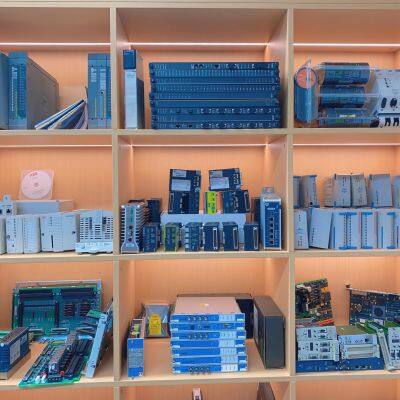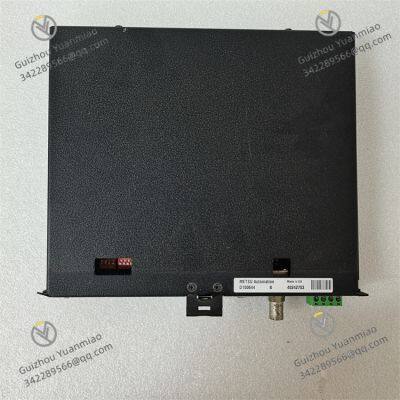Product Description
I. Overview
METSO D100644 is an Ethernet Coax Field Bus Converter. Its core function is to realize seamless communication connection between Ethernet-based devices and industrial fieldbus systems. Through efficient data conversion and transmission mechanisms, it enables devices with different communication protocols to smoothly exchange data, greatly improving the integration and compatibility of industrial control systems. It plays a key bridging role in complex industrial network architectures, helping enterprises build more intelligent and efficient production and operation systems.

II. Technical Parameters
Physical Specifications: Adopting a compact and lightweight design concept, it has a size of only 6.5 cm x 4.5 cm x 2.0 cm and a weight of approximately 100 grams. Such a small size makes it extremely convenient to install, as it can be easily integrated into various control cabinets or equipment with limited space without occupying too much valuable installation space. Moreover, it is convenient for integration and deployment in existing systems, reducing modifications to the original system structure.
Power Requirements: It supports a wide range of AC voltage input, with a power supply voltage of 100 – 240V AC. This broad voltage adaptability allows it to be compatible with industrial power supply standards in different regions around the world. Whether in developed regions with relatively stable voltage or developing regions with relatively complex power supply conditions, it can operate stably, ensuring reliable power supply for the equipment and reducing the risk of equipment failure caused by voltage issues.
Communication Interfaces: Equipped with a standard Ethernet interface and a coaxial interface suitable for various industrial fieldbuses. The Ethernet interface follows common network communication protocols, with flexible transmission rates, which can meet high-speed data transmission under different data flow requirements. The coaxial interface is optimally designed for various mainstream industrial fieldbus systems, ensuring stable connection and efficient communication with field devices. It can well adapt to fieldbus protocols such as Modbus and Profibus.
Temperature Adaptability: It has excellent environmental temperature tolerance, with an operating temperature range of -20℃ to 70℃. Whether in cold outdoor industrial facilities or high-temperature industrial production workshops, such as high-temperature working environments like steel smelting and chemical manufacturing, it can maintain normal working conditions, ensuring stable and reliable data conversion and communication functions of the equipment under different temperature conditions.
EMC Characteristics: It performs excellently in terms of electromagnetic compatibility, and its design fully complies with EMC (Electromagnetic Compatibility) regulatory requirements without the need for additional shielding enclosures and other auxiliary measures. This means that in complex industrial electromagnetic environments, such as scenarios where there are a large number of strong electromagnetic interference sources like motors and frequency converters, the device can effectively resist external electromagnetic interference, ensure the accuracy and integrity of its own communication data, and at the same time, will not cause electromagnetic interference to other surrounding electronic devices, thus guaranteeing the stable operation of the entire industrial control system.

III. Functional Features
Protocol Conversion and Communication Integration: It has a powerful protocol conversion function, which can realize real-time conversion between Ethernet protocols and various industrial fieldbus protocols. In industrial automated production lines, it enables barrier-free data interaction between Ethernet-based upper computers (such as monitoring computers and servers) and underlying devices using fieldbus communication (such as sensors, actuators, PLCs, etc.). For example, it can accurately convert the Ethernet-format control commands sent by the upper computer into fieldbus format and transmit them to the actuators, and at the same time convert the fieldbus data collected by the sensors into Ethernet format and feed them back to the upper computer, thereby realizing precise control and efficient management of the entire production process.
Easy Installation and Debugging: The installation process is simple and quick. The bottom of the control unit is equipped with detachable screw terminals, which facilitate operators to connect cables without complex tools or professional skills. At the same time, the device has a built-in grounding connection point for connecting the cable shielding layer, effectively improving anti-interference ability. In terms of debugging, it provides a detailed step-by-step operation guide to help users quickly complete the initial setup of the device. It also presets standard measurement modes, and users can easily configure analog/digital input and output interfaces according to actual needs, which greatly shortens the installation and debugging cycle of the device and reduces the difficulty and cost of system integration.
Self-Diagnosis and Remote Monitoring: It has a built-in advanced self-diagnostic test system, which can not only real-time monitor the operation status of the device itself, such as hardware failures and communication abnormalities, but also detect connected external devices such as sensors. Once a problem is found, it will immediately issue an alarm and record detailed fault information, providing maintenance personnel with accurate clues for fault investigation and improving the maintenance efficiency of the device. In addition, through the network connection function, it supports remote access and monitoring. Operators can real-time view the operating parameters and diagnostic information of the device in the remote monitoring center, and can also perform remote operations such as parameter adjustment and device restart. It is especially suitable for centralized management of large industrial plants or widely distributed industrial facilities, greatly improving the operation and maintenance convenience and management efficiency of the device.

IV. Application Scenarios
Automated Production Lines in Manufacturing: In large-scale automated production lines such as automobile manufacturing and electronic equipment manufacturing, there are a large number of different types of equipment. Some use Ethernet communication for high-speed data transmission and centralized control, while others rely on fieldbuses to achieve close collaboration and real-time response between devices. METSO D100644 can connect these devices with different communication protocols into an organic whole, realizing seamless connection and precise control of various links in the production line from raw material processing, component assembly to finished product inspection and packaging. For example, in an automobile assembly workshop, it can enable the Ethernet-based upper computer responsible for overall production scheduling to work in coordination with various automated assembly equipment (such as robotic arms and tightening machines) using fieldbus communication, ensuring the accuracy and efficiency of each assembly step, and improving production efficiency and product quality.
Energy and Power Industry: In energy and power facilities such as power plants and substations, monitoring systems are usually based on Ethernet architecture for data aggregation and remote control, while various on-site devices such as sensors (such as temperature sensors and pressure sensors), smart meters, and protection devices mostly use fieldbus communication. D100644 can realize communication conversion between the monitoring system and on-site devices, real-time collect operating parameters of power equipment, such as the temperature, voltage, and current of generators, and the oil temperature and oil level of transformers, and accurately transmit these data to the monitoring center, so that operation and maintenance personnel can timely grasp the operating status of the equipment, conduct fault early warning and equipment maintenance, ensure the safe and stable operation of the power system, and reduce the probability of power outages.
Chemical Production Process Control: The chemical production process involves many complex process flows and high-precision control requirements. Various reactors, pipelines, pumps, valves and other equipment need to achieve collaborative control through communication networks. METSO D100644 can connect fieldbus communication devices in chemical production sites (such as flow control valves and temperature controllers) with Ethernet-based central control systems, realizing real-time monitoring and precise control of key parameters such as temperature, pressure, flow, and liquid level in the production process. Once a parameter is abnormal, the system can quickly respond and adjust the operating status of related equipment to avoid safety accidents caused by parameter out of control. At the same time, through real-time data transmission and analysis, it optimizes the production process and improves the quality and production efficiency of chemical products.


ABB GFD563A102 3BHE046836R0102 Excitation Convection Interface Module
ABB PPD117A3011 3BHE030410R3011 Excitation Controller
ABB PCD231B101 3BHE025541R0101 Excitation Unit Controller
ABB 5SHY3545L0010 3BHE009681R0101 High-Voltage Thyristor Module
ABB PCD230A 3BHE022291R0101 Controller Module
ABB 5SHY3545L0009 3BHB013085R0001 IGBT Module
Bently Nevada 3500/25 enhanced key phase module
Bently Nevada 3500/32 4-channel relay module
ABB PCD232A 3BHE022293R0101 Exciter Control Module
Bently Nevada 3500 monitoring system series modules
Bently Nevada 3500/33 relay module
ABB PCD235A101 3BHE032025R0101 Excitation Control Module
ABB PCD235C101 3BHE057901R0101 Excitation Unit Controller
Bently Nevada 3500/34 Triple redundant relay module
ABB PCD530A102 3BHE041343R0102 Controller
ABB PPD113B01-10-150000 3BHR023784R1023 Controller Module
ABB PPD512A10-150000 3BHE040375R1023 Excitation Controller
Bently Nevada 3500/40 monitor module
 yezi
Hi there! Welcome to my shop. Let me know if you have any questions.
yezi
Hi there! Welcome to my shop. Let me know if you have any questions.





